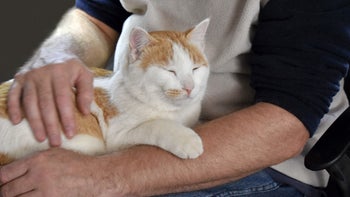
Buprenorphine for Cats: An Opioid Medication to Help Reduce Pain
Key takeaways:
Buprenorphine is an opioid medication used to reduce pain in cats. Because it’s an opioid, it is a federally controlled substance.
Common side effects of buprenorphine in cats include sedation, hyperactivity, increased affectionate behavior, and vomiting.
Buprenorphine comes as an injectable or a solution applied to the skin. When buprenorphine is prescribed for use at home, it’s commonly applied to the cat’s gums.
Table of contents

Cats are good at masking their pain. But that doesn’t mean they don’t experience significant discomfort.
Veterinarians use several medications to help manage pain in cats. Buprenorphine is one of these options.
Find out more about buprenorphine for cats and how this medication helps with pain control.
Search and compare options
Buprenorphine for cats at a glance
Common names | Buprenorphine (Buprenex, Simbadol, Zorbium) |
What it treats | Pain |
How it comes (forms) | Injectable, oral solution, transdermal solution |
Common side effects | Sedation, vomiting, hyperactivity, increased affectionate behavior, high temperature, dilated pupils |
What is buprenorphine for cats, and how does it work?
Buprenorphine is an opioid partial agonist. Like other opioids, buprenorphine acts on the receptors that regulate pain. These receptors are located in the brain and spinal cord, which are collectively called the central nervous system. By acting on these receptors, buprenorphine decreases the cat’s perception of pain.
Buprenorphine is considered a controlled substance by the FDA. Two forms of buprenorphine are FDA approved for use in cats:
Simbadol: a high-dose injection of buprenorphine that lasts for 24 hours
Zorbium: a solution applied to the skin that lasts for 4 days
Other forms of buprenorphine are prescribed off-label even though they’re often used in cats. This is common in veterinary medicine.
What is buprenorphine used for in cats?
The main use of buprenorphine in cats is to reduce pain, including:
Reduction of pain after surgery
Reduction of pain following traumatic injury
As part of a pre-anesthetic combination of medications
Identifying pain symptoms in cats: Cats are good at hiding their pain, so brush up on these common signs of pain in our feline companions.
Treating arthritis: Arthritis is a common concern among cats of a certain age. Here’s how you can help your cat manage arthritis pain.
Staying on top of vet visits: Cats should see their veterinarian at least once a year for an annual checkup. Cats over age 10 should go twice a year.
How is buprenorphine given for cats?
Buprenorphine for cats comes as an injectable solution, an oral solution given by mouth, or as a solution to be applied on the skin.
The buprenorphine injection is most commonly given at the veterinary clinic. Normal buprenorphine is injected into the muscle or vein every 8 to 12 hours. The high-concentration medication Simbadol is injected under a cat’s skin once daily for up to 3 days. This medication lasts for 24 hours.
The oral solution can be sent home to be used as a transmucosal treatment every 8 to 12 hours. This means that the liquid is applied to and absorbed through a cat’s gums. This allows owners to give buprenorphine to their pets without having to inject them.
Read more like this
Explore these related articles, suggested for readers like you.
Zorbium — a specific brand of buprenorphine — is applied by your veterinarian to the skin on the back of your cat’s neck. This is usually done 1 to 2 hours prior to surgery. The medication is rapidly absorbed. Zorbium lasts for 4 days. It comes in a predosed tube for small or large cats.
What are the common side effects of buprenorphine in cats?
Buprenorphine can have several side effects in cats, including:
Increased affectionate behavior
Hyperactivity
Sedation or lethargy
Increased body temperature
Dilated pupils
Decreased appetite and vomiting
Slow or shallow breathing
What are the most serious risks of buprenorphine for cats?
The most serious risk of buprenorphine is slowed or shallow breathing. But buprenorphine is less likely to cause this side effect compared with other opioids.
Buprenorphine can also cause an increase in body temperature (hyperthermia). The cat’s high temperature will go down on its own as the medication wears off. However, there is a risk that hyperthermia could mask a true fever.
An overdose of buprenorphine is rarely life-threatening for a cat.
Does buprenorphine interact with any other cat medications?
Buprenorphine can interact with several other medications, including:
Seizure medications like phenobarbital, phenytoin, diazepam, and midazolam
Antihistamines like diphenhydramine
Central nervous system depressants like anesthetics or tranquilizers
Desmopressin
Erythromycin
Antifungals like itraconazole
Metoclopramide
Naloxone
Other opioids like fentanyl or tramadol
Antianxiety medications like fentanyl or trazodone
Tell your veterinarian about any prescription medications, over-the-counter medications, and supplements your cat is taking.
What should you do if your cat misses a dose of buprenorphine?
If you miss giving your cat a dose of buprenorphine, give the missed dose as soon as you remember. Then adjust the timeline so that your cat is getting the medication as often as your veterinarian recommended.
Remember that buprenorphine is a controlled substance. This means it has potential for abuse. So keep your cat’s buprenorphine somewhere safe.
The bottom line
Buprenorphine is a good option for managing pain in cats, especially postsurgical pain. Although buprenorphine is generally safe to use, it can cause sedation, hyperactivity, increased body temperature, increased affectionate behavior, and vomiting. A serious but rare side effect in cats is slowed breathing.
Because buprenorphine is a controlled substance, it’s important that you keep it in a safe location and use it as instructed. If you have any concerns about buprenorphine for cats, contact your veterinarian for advice.
Why trust our experts?



References
Brooks, W. (2022). Buprenorphine (Buprenex). Veterinary Partner.
Cannarozzo, C. J., et al. (2021). Retrospective investigation of an association between high-dose buprenorphine and perpetuation of post-anesthesia hyperthermia in cats following ovariohysterectomy. Journal of Feline Medicine and Surgery.
Clark, T. P. (2022). The history and pharmacology of buprenorphine: New advances in cats. Journal of Veterinary Pharmacology and Therapeutics.
Drug Enforcement Administration. (2022). Buprenorphine.
Elanco. (n.d.). Zorbium (buprenorphine transdermal solution) for cats.
Steagall, P. V., et al. (2022). 2022 ISFM consensus guidelines on the management of acute pain in cats. Journal of Feline Medicine and Surgery.
Steagall, P. V. M., et al. (2014). A review of the studies using buprenorphine in cats. Journal of Veterinary Internal Medicine.
U.S. Food and Drug Administration. (2022). FDA approves first transdermal buprenorphine for the control of post-surgical pain in cats.
Zoetis, Inc. (2023). Simbadol- buprenorphine injection [package insert]. DailyMed.


























